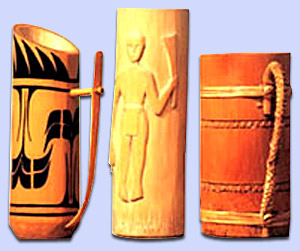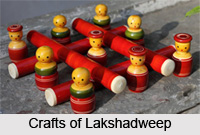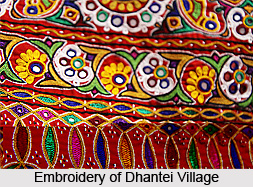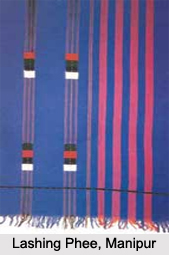 Apart from the Phanek, one of the wonder textiles of Manipur is Lashing phee (Lashing = cotton; phee = cloth), so named since it is a needled textile stuffed with cotton slivers. It is usually woven either with Loins loom or throw shuttle loom. Cotton sliver is introduced alternately in weft on which warp runs creating a thick stuffed fabric with wavy surfaces. Depending on the colour of yarn used, Lashing phee of different designs are produced. The textile is usually made either by the Meithei or the Loi women, settled in Manipur or elsewhere. However in quality and design, Lashing phee of the Lois are considered to be the best, particularly the fabric produced by the Lois of Fayang village being most famous.
Apart from the Phanek, one of the wonder textiles of Manipur is Lashing phee (Lashing = cotton; phee = cloth), so named since it is a needled textile stuffed with cotton slivers. It is usually woven either with Loins loom or throw shuttle loom. Cotton sliver is introduced alternately in weft on which warp runs creating a thick stuffed fabric with wavy surfaces. Depending on the colour of yarn used, Lashing phee of different designs are produced. The textile is usually made either by the Meithei or the Loi women, settled in Manipur or elsewhere. However in quality and design, Lashing phee of the Lois are considered to be the best, particularly the fabric produced by the Lois of Fayang village being most famous.
Silk and sericulture is still being practised by the Lois of few select hamlets, who could develop silk fabrics of various designs. One of the well known designs of silk fabric produced by the Lois of Laimram village is Moirang phee. As the name suggests, it was a type of cloth specially designed for the royal women of Moirang particularly. Later, perhaps when Manipur (or Meithei Laipak) was brought under the rule of a king of Ningthouja clan, the costume became common to all. It is said that this dress was first worn by the mythical princess of Manipur, Thoibi. It is more or less a typical Phanek, only temple like designs above the embroidered border which are made with block printing.
Production of Muga silk is reported only in the Jiribam town near Assam border, perhaps because of influence of the neighbouring state. However, Manipuri Muga is inferior to that of Assam, certainly not as good as the one produced in the Sualkuchi town of the Kamrup region. Kameng Chatpa is a white cloth with purple patterns of scrolls stamped on it by means of wooden blocks, which are said to have been introduced by the Chinese merchants who visited Manipur during the reign of King Khagemba around 14th or 15th century. During pre independence era when the state was ruled by the feudal kings, the cloth was not worn by persons of inferior rank and only the Rajkumars were permitted to use it at their pleasure. The same privilege was later extended to the sons-in-law of the king. After independence, however, it was extended to commoners with the impact of democracy.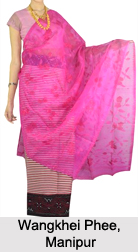
"Phee-gu-napu" is an orange coloured cloth which was meant for the persons of higher class before independence, but later became open to public. "Ju-gi-mairi" is a red coloured cloth which was worn in the presence of the king, by those who held titles of office as members of the "chirap" or by the favour of the king. It was open to public as well in earlier times, but in absence of the king. "Gulap machu" is a rose coloured silk cloth of pretty pink shade, worn by privileged persons who held office or enjoyed the royal favour but was open to public only if used in absence of the king. It is now freely open to public.
Wangkhei is a small cluster close to the capital city Imphal. Traditionally, women of this cluster were known for dyeing yarn or cloth. But subsequently, they developed design weaving and created a niche in the market. Being close to the capital city, this cluster has an advantage to interact with the designs of other states and thus create a new wave. There are designs identical to the Jamdani of Bengal, where patterns are created by a brocading technique. There are also traditional Meithei designs and often two designs are mixed together to bring new motifs. These cloths are known as Wangkhei phee and are today extremely popular. They make cloths of two and a half metre length worn over the Phanek and over five meters long worn as sarees, depending on the market demand.
The Meithei weavers also weave beautiful bed sheets, bed covers, curtains etc. with the help of cotton yarn with typical floral and geometrical designs. They also make scarves as winter garment or simply as fashion, with typical design for which they use draw boy or dobby and jacquard. There are a few hamlets famous for this type of textile goods, namely Kakching, Bamdiar, Bishnupur, Thoubal and so on. Use of turban or "pugree" has been discontinued since last few decades due to influence of modernisation, but was used commonly as a symbol of status. Pugrees with silk patterned ends were used by the descendants and relatives of the King, and by those whom it was conferred upon as a mark of favour or distinction. No one was permitted to wear turbans with silk border in presence of Kings. Lam Khong Poak with a turban with projected front was used by wrestlers and runners when performing in public. Faicharang, a cap worn by the ladies of high rank, is first mentioned in 1746 AD when the queen of King Pamheiba donned it at a dancing party of the Chothe Nagas in their village.
Even mosquito nets made and used by the Meitheis are unique, each of them embroidered beautifully with various colours, thus making their bedrooms well decorated. Thus, mosquito net production is in itself a craft and these products are even often exported from the state.
Related Articles:
Manipur
Crafts of Manipur
Tribes of Manipur
Meithei Language
Indian Costumes
Weaving and Dyeing Craft
Silk Weaving in South India
Silk
Cotton
Cotton Fabrics



